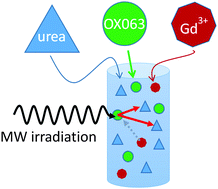The effect of Gd on trityl-based dynamic nuclear polarisation in solids†
Abstract
In dynamic nuclear polarisation (DNP) experiments performed under static conditions at 1.4 K we show that the presence of 1 mM Gd(III)-DOTAREM increases the 13C polarisation and decreases the 13C polarisation buildup time of 13C-urea dissolved in samples containing water/DMSO mixtures with trityl radical (OX063) concentrations of 10 mM or higher. To account for these observations further measurements were carried out at 6.5 K, using a combined EPR and NMR spectrometer. At this temperature, frequency swept DNP spectra of samples with 5 or 10 mM OX063 were measured, with and without 1 mM Gd-DOTA, and again a 13C enhancement gain was observed due to the presence of Gd-DOTA. These measurements were complemented by electron–electron double resonance (ELDOR) measurements to quantitate the effect of electron spectral diffusion (eSD) on the DNP enhancements and lineshapes. Simulations of the ELDOR spectra were done using the following parameters: (i) a parameter defining the rate of the eSD process, (ii) an “effective electron–proton anisotropic hyperfine interaction parameter”, and (iii) the transverse electron spin relaxation time of OX063. These parameters, together with the longitudinal electron spin relaxation time, measured by EPR, were used to calculate the frequency profile of electron polarisation. This, in turn, was used to calculate two basic solid effect (SE) and indirect cross effect (iCE) DNP spectra. A properly weighted combination of these two normalized DNP spectra provided a very good fit of the experimental DNP spectra. The best fit simulation parameters reveal that the addition of Gd(III)-DOTA causes an increase in both the SE and the iCE contributions by similar amounts, and that the increase in the overall DNP enhancements is a result of narrowing of the ELDOR spectra (increased electron polarisation gradient across the EPR line). These changes in the electron depolarisation profile are a combined result of shortening of the longitudinal and transverse electron spin relaxation times, as well as an increase in the eSD rate and in the effective electron-proton anisotropic hyperfine interaction parameter.


 Please wait while we load your content...
Please wait while we load your content...